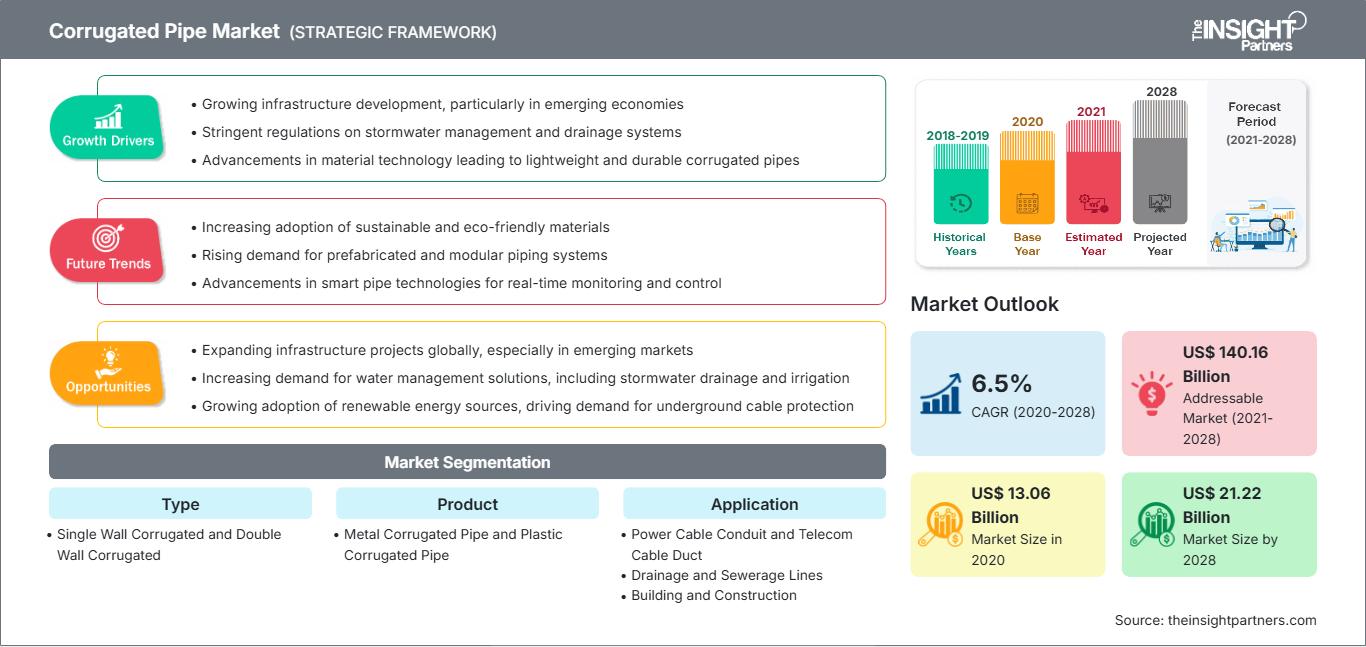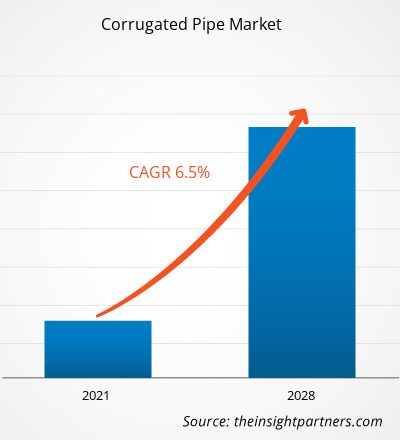Il mercato dei tubi corrugati è stato valutato a 13.059,47 milioni di dollari nel 2020 e si prevede che raggiungerà i 21.221,04 milioni di dollari entro il 2028; si prevede una crescita a un CAGR del 6,5% dal 2021 al 2028.
Un tubo corrugato presenta una serie di creste e scanalature parallele sulla sua superficie. I tubi corrugati possono essere realizzati in acciaio o materiali plastici come polietilene ad alta densità (HDPE) e cloruro di polivinile (PVC). I tubi corrugati sono utilizzati principalmente in applicazioni come scarichi pluviali e tombini, dove flessibilità, durata e resistenza sono caratteristiche importanti. La flessibilità dei tubi corrugati li rende più utili e adatti a un'ampia varietà di applicazioni rispetto ai tubi rigidi e non corrugati.
Nel 2020, l'Asia-Pacifico ha rappresentato la quota maggiore del mercato globale dei tubi corrugati. I crescenti sviluppi nei settori manifatturiero, edile e delle costruzioni stanno trainando la domanda di tubi corrugati in questa regione. Anche il vasto e consolidato settore agricolo in paesi come Cina e India sta aumentando la domanda di tubi corrugati da utilizzare nei sistemi di irrigazione e drenaggio. Parallelamente, lo sviluppo e la crescente penetrazione delle telecomunicazioni nell'area Asia-Pacifico stanno ulteriormente stimolando la crescita del mercato dei tubi corrugati.
L'attuale pandemia di COVID-19 ha avuto un impatto significativo sul mercato dei tubi corrugati. L'epidemia ha distorto l'efficienza operativa e interrotto le catene del valore a causa dell'improvvisa chiusura dei confini nazionali e internazionali, causando perdite di fatturato e danni. Le interruzioni nella produzione e nella catena di approvvigionamento hanno avuto un impatto negativo sul mercato dei tubi corrugati. Diversi paesi in tutto il mondo hanno dovuto affrontare situazioni di lockdown a causa dell'epidemia di COVID-19, che hanno costretto diverse aziende, come il settore edile e agricolo, a operare con capacità limitate, il che, a sua volta, ha gravemente influenzato il mercato dei tubi corrugati. Parallelamente, anche il settore delle costruzioni ha subito un crollo, con conseguente impatto sulla domanda di cloruro di polivinile (PVC) utilizzato nei tubi. Pertanto, la scarsa domanda da parte delle industrie di utilizzo finale ha avuto un impatto negativo sul mercato dei tubi corrugati. Sono in corso diverse ricerche in paesi come Regno Unito, Paesi Bassi e Spagna su campioni di acque reflue per individuare eventuali segnali di COVID-19. Il monitoraggio e la gestione delle acque reflue sono diventati più importanti durante la pandemia, così come il trattamento dei rifiuti, inclusi quelli medici, domestici e altri rifiuti pericolosi, per ridurre al minimo i possibili impatti secondari sulla salute e sull'ambiente. Con l'aumento dei casi in molte parti del mondo in via di sviluppo, si è assistito a una maggiore attenzione alla gestione dei rifiuti. I governi di diversi paesi si stanno concentrando sulla separazione delle acque reflue, che prevede il convogliamento delle acque nere, grigie e cariche di sostanze chimiche tossiche in corsi d'acqua municipali separati. Questa attenzione alla gestione delle acque reflue avrà un impatto positivo sul mercato dei tubi corrugati.
Personalizza questo rapporto in base alle tue esigenze
Potrai personalizzare gratuitamente qualsiasi rapporto, comprese parti di questo rapporto, o analisi a livello di paese, pacchetto dati Excel, oltre a usufruire di grandi offerte e sconti per start-up e università
Mercato dei tubi corrugati: Approfondimenti strategici

-
Ottieni le principali tendenze chiave del mercato di questo rapporto.Questo campione GRATUITO includerà l'analisi dei dati, che vanno dalle tendenze di mercato alle stime e alle previsioni.
I tubi corrugati presentano una serie di creste e scanalature sulla superficie che corrono parallele tra loro. Queste creste e scanalature seguono uno schema: sono perpendicolari e bisecano la linea centrale della tubazione. I tubi corrugati sono sempre più utilizzati nei sistemi fognari e di drenaggio grazie ai vari vantaggi operativi ad essi associati. I tubi offrono prestazioni di lunga durata grazie alla bassa abrasione delle pareti interne e alla resistenza agli acidi e ad altri fluidi, e supportano anche portate elevate. Inoltre, questi tubi sono leggeri e resistenti. Di conseguenza, sono necessarie poche risorse per la loro installazione e possono essere installati in aree ristrette. Questi sistemi di tubazioni garantiscono l'integrità dei giunti, presentando quindi giunzioni ermetiche e a tenuta stagna. I tubi corrugati sono inoltre caratterizzati da bassi costi operativi dovuti ai minori costi di trasporto, poiché è possibile caricare su un camion un numero maggiore di tubi a doppia parete con meno danni durante lo stoccaggio e la movimentazione, a differenza dei tubi in calcestruzzo. Inoltre, la minore necessità di manodopera per l'installazione riduce i costi di installazione. I tubi corrugati possono essere utilizzati per il drenaggio delle acque piovane e per il drenaggio sotterraneo. I sistemi di drenaggio delle acque piovane richiedono un'ampia gamma di dimensioni e vengono installati principalmente in parcheggi e aree verdi. I tubi corrugati a doppia parete vengono utilizzati in queste strutture di drenaggio per la loro durata, robustezza e alte prestazioni; l'elevata durata e robustezza li rendono meno soggetti a crepe. I sistemi di drenaggio sotterraneo utilizzano comunemente tubi corrugati in polietilene ad alta densità (HDPE) per dirigere il trasporto sotterraneo delle acque. Questi tubi sono ideali per il controllo dei livelli delle falde acquifere e della percolazione delle acque superficiali in campi sportivi, campi agricoli, campi da golf, progetti di sviluppo collinare e così via. Pertanto, il crescente utilizzo di tubi corrugati nei sistemi di drenaggio e fognatura sta stimolando la crescita del mercato dei tubi corrugati.
Approfondimenti sulle tipologie
In base alla tipologia, il mercato dei tubi corrugati è segmentato in tubi corrugati in metallo e tubi corrugati in plastica. Il segmento dei tubi corrugati in plastica ha detenuto la quota maggiore del mercato globale dei tubi corrugati nel 2020. Il tubo corrugato in plastica è uno dei prodotti di drenaggio chimicamente più inerti disponibili per i consumatori, il che lo rende altamente resistente ai gas corrosivi e alle sostanze chimiche. I tubi corrugati in plastica sono realizzati principalmente in polietilene ad alta densità (HDPE), cloruro di polivinile (PVC) e polipropilene (PP), tra gli altri, e vengono utilizzati per manovrare in corridoi di servizio congestionati, adattarsi a condizioni di cantiere specifiche o attraversare terreni difficili.
Alcuni dei principali attori del mercato dei tubi corrugati sono Advanced Drainage Systems, Bina Plastic Industries Sdn. Bhd, Jain Irrigation Systems Ltd., Fränkische Industrial Pipes Gmbh and Co. Kg, Dura Life India, Contech Engineered Solutions LLC, JM Eagle Inc., Pacific Corrugated Company, Pars Ethylene Kish Co. e TDR Inc. I principali attori del mercato si stanno concentrando su strategie come fusioni e acquisizioni. acquisizioni e lanci di prodotti per espandere la presenza geografica e la base di consumatori.
Mercato dei tubi corrugatiLe tendenze regionali e i fattori che influenzano il mercato dei tubi corrugati durante il periodo di previsione sono stati ampiamente spiegati dagli analisti di The Insight Partners. Questa sezione analizza anche i segmenti e la geografia del mercato dei tubi corrugati in Nord America, Europa, Asia-Pacifico, Medio Oriente e Africa, America Meridionale e Centrale.
Ambito del rapporto sul mercato dei tubi corrugati
| Attributo del rapporto | Dettagli |
|---|---|
| Dimensioni del mercato in 2020 | US$ 13.06 Billion |
| Dimensioni del mercato per 2028 | US$ 21.22 Billion |
| CAGR globale (2020 - 2028) | 6.5% |
| Dati storici | 2018-2019 |
| Periodo di previsione | 2021-2028 |
| Segmenti coperti |
By Tipo
|
| Regioni e paesi coperti |
Nord America
|
| Leader di mercato e profili aziendali chiave |
|
Densità degli operatori del mercato dei tubi corrugati: comprendere il suo impatto sulle dinamiche aziendali
Il mercato dei tubi corrugati è in rapida crescita, trainato dalla crescente domanda degli utenti finali, dovuta a fattori quali l'evoluzione delle preferenze dei consumatori, i progressi tecnologici e una maggiore consapevolezza dei vantaggi del prodotto. Con l'aumento della domanda, le aziende stanno ampliando la propria offerta, innovando per soddisfare le esigenze dei consumatori e sfruttando le tendenze emergenti, alimentando ulteriormente la crescita del mercato.

- Ottieni il Mercato dei tubi corrugati Panoramica dei principali attori chiave
- Tendenze progressive nel settore dei tubi corrugati per aiutare gli operatori a sviluppare strategie efficaci a lungo termine
- Strategie di crescita aziendale adottate dalle aziende per garantire la crescita nei mercati sviluppati e in via di sviluppo
- Analisi quantitativa del mercato globale dei tubi corrugati dal 2019 al 2028
- Stima della domanda di tubi corrugati in vari settori
- Analisi di Porter per illustrare l'efficacia di acquirenti e fornitori che operano nel settore per prevedere la crescita del mercato
- Sviluppi recenti per comprendere lo scenario competitivo del mercato e la domanda di tubi corrugati
- Tendenze e prospettive di mercato insieme ai fattori che guidano e frenano la crescita del mercato dei tubi corrugati
- Comprensione delle strategie che sostengono l'interesse commerciale per quanto riguarda la crescita del mercato globale dei tubi corrugati, aiutando nel processo decisionale
- Dimensioni del mercato dei tubi corrugati in vari nodi del mercato
- Panoramica dettagliata e segmentazione del mercato globale mercato dei tubi corrugati e dinamiche del settore
- Dimensioni del mercato dei tubi corrugati in varie regioni con promettenti opportunità di crescita
Mercato dei tubi corrugati, per tipo
- Corrugato a parete singola
- Corrugato a doppia parete
Mercato dei tubi corrugati, per prodotto
- Tubo corrugato in metallo
- Tubo corrugato in plastica
Mercato dei tubi corrugati, per applicazione
- Condotti per cavi elettrici e canaline per cavi per telecomunicazioni
- Linee di drenaggio e fognatura
- Edilizia e costruzioni
Profili aziendali
- Sistemi di drenaggio avanzati
- Bina Plastic Industries Sdn. Bhd
- Jain Irrigation Systems Ltd.
- Fränkische Industrial Pipes Gmbh and Co. Kg
- Dura Life India
- Contech Engineered Solutions LLC
- JM Eagle Inc.
- Pacific Corrugated Company
- Pars Ethylene Kish Co.
- TDR Inc
- Analisi storica (2 anni), anno base, previsione (7 anni) con CAGR
- Analisi PEST e SWOT
- Valore/volume delle dimensioni del mercato - Globale, Regionale, Nazionale
- Industria e panorama competitivo
- Set di dati Excel
Report recenti
Testimonianze
Motivo dell'acquisto
- Processo decisionale informato
- Comprensione delle dinamiche di mercato
- Analisi competitiva
- Analisi dei clienti
- Previsioni di mercato
- Mitigazione del rischio
- Pianificazione strategica
- Giustificazione degli investimenti
- Identificazione dei mercati emergenti
- Miglioramento delle strategie di marketing
- Aumento dell'efficienza operativa
- Allineamento alle tendenze normative






















 Ottieni un campione gratuito per - Mercato dei tubi corrugati
Ottieni un campione gratuito per - Mercato dei tubi corrugati